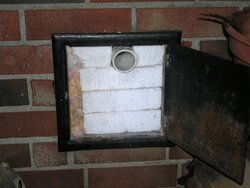Hogwildz
Minister of Fire
Shamong13 said:I have a PE Summit insert and have been struggling with poor heat output since it was installed in November 2007. I have a 6-inch full SS liner and a blockoff plate with ceramic fiber insulation above the plate. Origonally, I was using outside air, but determined that the insert was sucking in cool air into the plenum area and blowing cooler air (85-90 F) out the front. I plugged the outside air and removed the knocked out on the side and now the insert is blowing air out at a max of 115 F (better but still not good).
I can only get the insert to a maximum temp. of 540 F (taken above right corner of door). I have tried different wood (seasoned oak purchased and from friends, compress sawdust logs and kiln dry wood from the store). I can get a good fire, but poor heat output. I think my insert is overdrafting, but I have no good solution.
From my experience, over drafting will cause it to run hotter & burn faster. Not cooler.
If your top temp has been 540, something is seriously wrong. When are you cutting the air back? How tall is the chimney? If you gained hotter output after going with inside air. Thats a start.
Are you by chance shutting the air down too soon?


 .this way you know its not the chimney and not wasting time,wood etc.8" could give you more or less.dont know.all i know is the stove was made to run a 6".
.this way you know its not the chimney and not wasting time,wood etc.8" could give you more or less.dont know.all i know is the stove was made to run a 6".
